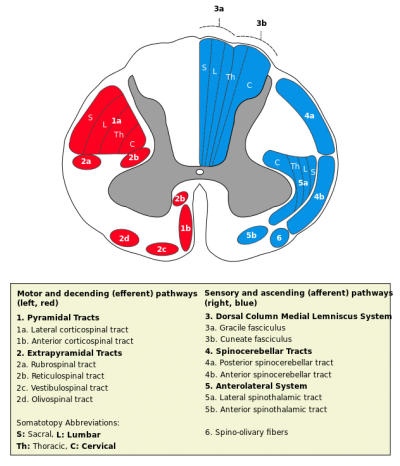Description
The Reticulospinal tract is responsible primarily for locomotion and postural control. The Reticulospinal tract is comprised of the medial (pontine) tract and the lateral (medullary) tract.[1]
Anatomy
Origin
- Reticular formation in the pontine (Medial Reticulospinal tract) and medulla (Lateral Reticulospinal tract)[2]
Course / Path
Medial Reticulospinal Tract (Pontine)
- Descends ipsilaterally in the anterior funiculus [1]
Lateral Reticulospinal tracts (Medullary)
- Descends bilaterally in the lateral funiculus [1]
Both the lateral and medial tracts act via internuncials shared with the corticospinal tract on proximal limb and axial muscle motor neurons.[1]
Function
- Control the activity of both alpha and gamma motor neurones[2]
- Mediate pressor and depressor effects on the circulatory system[2]
- Help to control breathing[2]
- Due to the interrelation between vestibulospinal and ipsilateral reticulospinal tracts, this can result in selective activation of many muscles at the same time. As they work through interneurons and long propriospinal neurons, they can enable co-ordinated, selective movements[3][4]. In addition this pathway in primates studies have shown the ability to code movements to select the appropriate level of force required for a muscle contraction[5]
- The relationship between the rubrospinal and crossed reticulospinal tracts can result in a postural role within distal musculature. The pathways innervate motorneurons both directly and indirectly through interneurons and short propriospinal neurons (e.g. intrinsic muscles acting in a postural role for individual finger movement) [4]
- In corticospinal tract leisons the reticulospinal tract is thought to contribute to upper limb recovery. Although the reticulospinal tract is thought to contract the hand weakly, these outputs can strengthen following leisons to the corticospinal tract[6]
Medial Reticulospinal Tract (Pontine)
- Responsible for controlling axial and extensor motor neurons e.g enable extension of the legs to maintain postural support [3]
- Stimulation of the midbrain locomotor centre can result patterned movements (e.g. stepping)[3]
Lateral Reticulospinal Tract (Medullary)
- Responsible for flexor motor neurons [2]
- Inhibits the medial reticulospinal tract and therefore extensor motor neurones enabling modulation of the stretch reflex [7]
Locomotion
When generating movements in two sides of the body within humans, it results in reciprocal inhibition of the flexors and extensors. Primate studies have suggested that the reticulospinal tract may facilitate flexors and suppress extensors ipsilaterally, and facilitate extensors and suppress flexors contralaterally[8]
In animal studies, central pattern generators (CPGs) are found to be responsible for locomotion generation. As locomotion is generated by internuncial neurons in the cervical and lumbar regions, activating the flexors and extensors, the intermediate gray matter is able to initiate rhythmical movements.[1]
In humans, locomotion is generated in the locomotion centre in the midbrain. The premotor cortex which is responsible for the overarching control of locomotion projects to the brainstem and therefore reticulospinal tract. As a consequence, the reticulospinal tract is able to modulate control of locomotion when working with the corticospinal tract.[1][9]The reticular formation, due to its role in attention and conscious perception, can result in a specific reaction to sensory information. The cortico-reticulospinal tract is thereby responsible for transmitting excitatory and inhibitory information to be processed before being passed to the spinal cord.[3] The cerebellum however is thought to be responsible for error correction and motor learning in gait, and the lateral hypothalamus is responsible for goal direction for locomotion e.g. hunger. [3]
Posture
The reticular formation within the pons is partly responsible for postural control functions. [3] The cortico-reticulospinal tract is involved in proximal stability and regulating postural tone. [3]
The premotor cortex is able to identify appropriate axial musculature to enable distal movement.[1] Due to the interrelation of internuncial neurons between the corticospinal and reticulospinal tracts can be responsible for controlling movement patterns. The reticulospinal tract can initiate movement within a stable, routine situation, whereas the corticospinal tract is able to control tasks requiring more cognitive appraisal (e.g. varying surface, distractions and requiring close attention). [2]
Pathology
Lesions to the cortico-reticulospinal system can result in decreased postural control and reduced selectivity of postural control.[3]
If the excitatory fibres in the reticular formation have a leison this can result in hypotonia by the loss of descending excitatatory impulses to the spinal cord. Conversly in the inhibitory fibres are disrupted in the reticular formation this could result in hypertonia (spasticity) As the lateral reticulospinal’s is involved in inhibition, if this pathway is disruped it can result in spasticity [7]. In addition due to the lack of descending inhibition, the medial reticulospinal tract would then maintain spasticity in the musculature.[7]
References
- ↑ 1.01.11.21.31.41.51.6 Fitzgerald MJT, Gruener G, Mtui E. Clinical neuroanatomy and neuroscience. Fifth Edition. Philadelphia: Elsevier Saunders, 2007
- ↑ 2.02.12.22.32.42.5 Crossman AR, Neary D. Neuroanatomy. An Illustrated colour text. Third Edition. Philadelphia: Churchill Livingstone, 2005
- ↑ 3.03.13.23.33.43.53.63.7 Gjelsvik BEB. The bobath concept in adult neurology. Stuttgart: Thieme, 2008
- ↑ 4.04.1 Baker SN. The primate reticulospinal tract, hand function and functional recovery. The Journal of physiology. 2011 Dec 1;589(23):5603-12.
- ↑ Buford JA, Davidson AG. Movement-related and preparatory activity in the reticulospinal system of the monkey. Experimental brain research. 2004 Dec 1;159(3):284-300.
- ↑ Zaaimi B, Edgley SA & Baker SN( 2009 ). Reticulospinal and ipsilateral corticospinal tract contributions to functional recovery after unilateral corticospinal lesion. 2009 Abstract Viewer/Itinerary Planner , Programme No. 568.529 . Society for Neuroscience , Washington, DC .
- ↑ 7.07.17.2 Trompetto C, Marinelli L, Mori L, Pelosin E, Currà A, Molfetta L, Abbruzzese G. Pathophysiology of spasticity: Implications for neurorehabilitation. BioMed research international. 2014 Oct 30;2014.
- ↑ Davidson AG, Schieber MH, Buford JA. Bilateral spike-triggered average effects in arm and shoulder muscles from the monkey pontomedullary reticular formation. The Journal of neuroscience. 2007 Jul 25;27(30):8053-8.
- ↑ Drew T, Prentice S, Schepens B. Cortical and brainstem control of locomotion. Progress in brain research. 2004 Dec 31;143:251-61.


